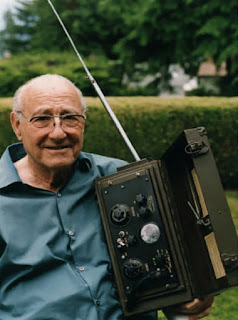Inventions History Machines
Canadian inventor Donald Hings was the first to create a portable radio signaling system for his employer CM&S in 1937. He called the system a "packset", although it later became known as a "walkie-talkie". In 2001, Hings was formally decorated for the device's significance to the war effort. Hings' model C-58 "Handy-Talkie" was in military service by 1942, the result of a secret R&D effort that began in 1940.
Alfred J. Gross, a radio engineer and one of the developers of the Joan-Eleanor system, also worked on the early technology behind the walkie-talkie between 1938 and 1941, and is sometimes credited with inventing it.
The first device to be widely nicknamed a "walkie-talkie" was developed by the US military during World War II, the backpacked Motorola SCR-300. It was created by an engineering team in 1940 at the Galvin Manufacturing Company (forerunner of Motorola). The team consisted of Dan Noble, who conceived of the design using frequency modulation; Henryk Magnuski, who was the principal RF engineer; Marion Bond; Lloyd Morris; and Bill Vogel.
The first handheld walkie-talkie was the AM SCR-536 transceiver from 1941, also made by Motorola, named the Handie-Talkie (HT). The terms are often confused today, but the original walkie-talkie referred to the back mounted model, while the handie-talkie was the device which could be held entirely in the hand. Both devices used vacuum tubes and were powered by high voltage dry cell batteries.
The first device to be widely nicknamed a "walkie-talkie" was developed by the US military during World War II, the backpacked Motorola SCR-300. It was created by an engineering team in 1940 at the Galvin Manufacturing Company (forerunner of Motorola). The team consisted of Dan Noble, who conceived of the design using frequency modulation; Henryk Magnuski, who was the principal RF engineer; Marion Bond; Lloyd Morris; and Bill Vogel.
The first handheld walkie-talkie was the AM SCR-536 transceiver from 1941, also made by Motorola, named the Handie-Talkie (HT). The terms are often confused today, but the original walkie-talkie referred to the back mounted model, while the handie-talkie was the device which could be held entirely in the hand. Both devices used vacuum tubes and were powered by high voltage dry cell batteries.
Following World War II, Raytheon developed the SCR-536's military replacement, the AN/PRC-6. The AN/PRC-6 circuit used 13 vacuum tubes (receiver and transmitter); a second set of thirteen tubes was supplied with the unit as running spares. The unit was factory set with one crystal which could be changed to a different frequency in the field by replacing the crystal and re-tuning the unit. It used a 24-inch whip antenna. There was an optional handset that could be connected to the AN/PRC-6 by a 5-foot cable. An adjustable strap was provided for carrying and support while operating. More details

